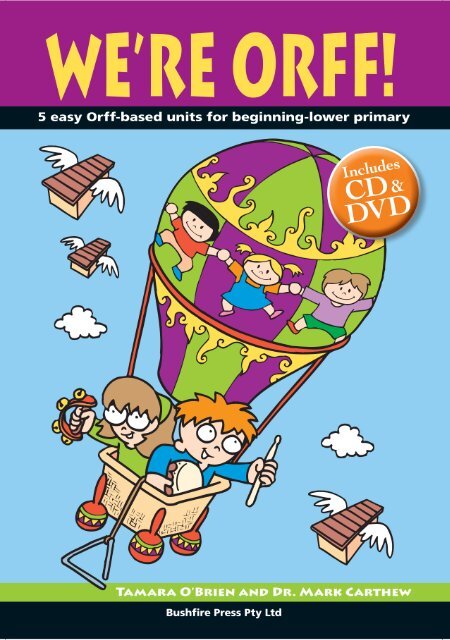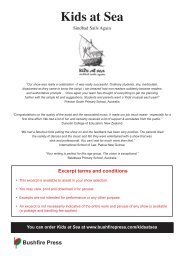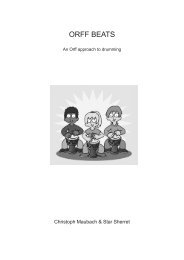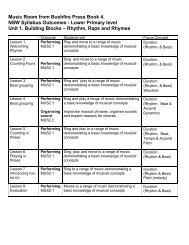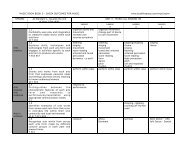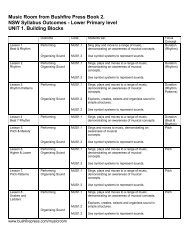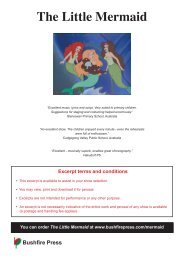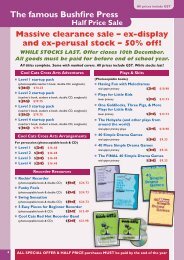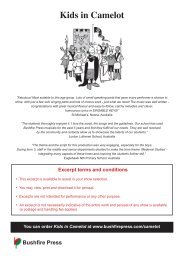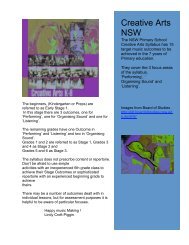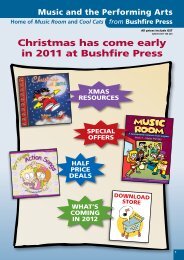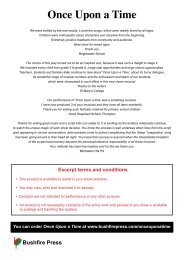How does We're Orff! work? - Bushfire Press
How does We're Orff! work? - Bushfire Press
How does We're Orff! work? - Bushfire Press
You also want an ePaper? Increase the reach of your titles
YUMPU automatically turns print PDFs into web optimized ePapers that Google loves.
WE’RE ORFF!<br />
5 Easy <strong>Orff</strong>-based units for beginning-lower primary.<br />
Tamara O’Brien & Mark Carthew<br />
<strong>Bushfire</strong> <strong>Press</strong> Pty Ltd
For Aedyn and Genevieve, whose laughter is my most cherished music - T O’B<br />
For Professor Emeritus Barbara van Ernst AM - MC<br />
The authors<br />
Tamara O’Brien - Dip. Screen Composition (AFTRS); Grad.Dip. Ed. <strong>Orff</strong> Music; B.Mus/B.ED<br />
Dr Mark Carthew - PhD(Swin), GradDipMusicEd, DipTeachingPrimary, DipFrontlineManagement, MACE<br />
Production<br />
Audio tracks produced & recorded by Tamara O’Brien. All instruments played by Tamara O’Brien; vocals by<br />
Tamara O’Brien, Aedyn Pratley & Genevieve Pratley.<br />
Filmed by Mark Leehy at the Verbrugghen Hall, Sydney Conservatorium of Music, 19th of May 2012.<br />
Still phtography by Paul Pratley.<br />
Post production and duplication by Phil King for Trans Image, Bayswater.<br />
Cover & art<strong>work</strong> by Bradfield Dumpleton.<br />
Cover design by Patricia Tsiatsias; book design by Kevin O’Mara.<br />
Printed & bound by Blue Star Print, Clayton.<br />
Thank-you to the Con for Kids students and the Sydney Conservatorium of Music, University of Sydney.<br />
Students:<br />
Agnes Barber, Holly Barnes, Rani Barnes, Thomas Beltran, Jannik Chan, Sophie Giannini, Jaden Holvik,<br />
Matthew Huynh, Si Young Kang, Anna Kotsiou, Hannah McCutcheon, Clancy McVay, Charles Morgan, Chloe<br />
Nakhoul, Dominic Nakhoul, Jasmin Nakhoul, Rachelle Nakhoul, James Nguyen, Marcus Ogden, Chloe<br />
Oong, Zara Oong, Aedyn Pratley, Justin Tse and Chantal Walther.<br />
Special thanks to<br />
Paul Pratley, Samantha Allen, Ting Lee, Aedyn Pratley, Genevieve Pratley, Bronwyn Pierce and Justin Ankus.<br />
First published 2012 by<br />
<strong>Bushfire</strong> <strong>Press</strong><br />
PO Box 787, Templestowe<br />
VIC 3106<br />
Australia<br />
Tel: 61 3 9846 1755; Fax: 61 3 9846 1744<br />
Email: bushfire@bushfirepress.com<br />
Website: www.bushfirepress.com<br />
ISBN: 978-1-876772-81-9<br />
ISMN: 979-0-72006-416-1<br />
This publication is protected under the Australian Copyright Act and the international Berne<br />
Convention and AMCOS. Any duplication, including photocopying or scanning or transmission or<br />
lending or re-selling of any part of this book or its accompanying audio and video disks without<br />
consent of the publisher prohibited. Offenders may be prosecuted.
Introduction<br />
Contents<br />
Foreword by Christoph Maubach iv<br />
The <strong>Orff</strong> Approach to music education v<br />
About this resource vi<br />
The units<br />
Unit 1: Flying Man 1<br />
Unit 2: Fiddle Diddle Dee 8<br />
Unit 3: Terracotta Pot 16<br />
Unit 4: Little Brown Owl 22<br />
Unit 5: Dinosaur 30<br />
Appendix<br />
Flying Man – conductor’s score 38<br />
Fiddle Diddle Dee – conductor’s score 46<br />
Terracotta Pot – conductor’s score 60<br />
Little Brown Owl – conductor’s score 64<br />
Dinosaur – conductor’s score 72<br />
Acknowledgements 77<br />
Audio CD tracklist 78
iv<br />
Foreword<br />
Creating music and music education activities that are appealing to the young, and the<br />
very young, can be a challenging undertaking. Tamara O’Brien and Mark Carthew have<br />
found an answer to this challenge and created a well-rounded publication, which offers a<br />
healthy oeuvre of songs, ideas and activities.<br />
Speech, rhyming, singing, dance movement, percussion, visual clues and all the<br />
advantages of modern technology make this an accessible publication full of good ideas.<br />
In a playful and child-centred approach, Tamara and Mark lead us to a world of musical<br />
imagination. The teaching–learning processes which are offered here follow the <strong>Orff</strong> way<br />
to music education. Children are involved through imitation, exploration and creation.<br />
For those who have never <strong>work</strong>ed with the <strong>Orff</strong> approach, the publication provides<br />
encouraging starting points. And for those who know about the <strong>Orff</strong> way to music<br />
education, there are plenty of ideas, and pedagogical signposts.<br />
We’re <strong>Orff</strong> takes children and educators into a world full of fun, imagination, moving about<br />
and sounding out – and all of it with a sense of ease.<br />
Christoph Maubach<br />
July 2012
<strong>Orff</strong> Shulwerk<br />
Creative music and movement education<br />
What is <strong>Orff</strong> Schulwerk?<br />
<strong>Orff</strong> Schulwerk is an approach to music education. It was developed by German composer and<br />
music educator Carl <strong>Orff</strong> (1895-1982) and colleague Gunild Keetman (1904-1990).<br />
<strong>How</strong> <strong>does</strong> it <strong>work</strong>?<br />
The <strong>Orff</strong> approach integrates Speech, Singing, Movement and Instruments to teach the elements<br />
of music.<br />
Students are immersed naturally, as in language-learning, into Hearing and Imitating, then Making<br />
Music, and, later, Reading and Writing music.<br />
Techniques include Imitation (simultaneous imitating), Echo, Ostinato, Canon, Question & Answer.<br />
Instruments and scale<br />
The <strong>Orff</strong> approach uses percussion instruments specifically chosen or designed for children.<br />
Both untuned and tuned percussion instruments are utilised.<br />
Untuned percussion: tambourines, tambours, claves (rhythm/tapping sticks), woodblocks,<br />
triangles, castanets, guiros, triangles etc.<br />
Tuned percussion: xylophones, glockenspiels, metallophones etc.<br />
A distinguishing feature in <strong>Orff</strong> Shulwerk is the use of the pentatonic (5 note) scale and the<br />
utilisation of tuned instruments with detachable bars. As all notes in a pentatonic scale will<br />
harmonise, fear of making a mistake is removed and students feel more comfortable to experiment.<br />
The pentatonic scale used in We’re <strong>Orff</strong>!’ is the C pentatonic. It uses the notes C D E G A.<br />
Removing the F and B bars on the instrument will instantly create this scale.<br />
Improvisation<br />
Students explore and create from the very beginning. As they learn more skills and techniques they<br />
draw upon these to explore, create and contribute to the musical experience.<br />
Inclusion<br />
The <strong>Orff</strong> approach is inclusive and each student contributes according to ability.<br />
<strong>Orff</strong> Shulwerk begins with simple tasks and develops to more complex activities, but the<br />
contributions of all students at all levels is easily incorporated into the musical experience, giving<br />
value both to individual creativity and group <strong>work</strong> – without the restrictions of technical ability.<br />
<strong>Orff</strong> associations<br />
Australian state organisations can be found at http://www.ancos.org.au/flash_index.htm<br />
International organisations can be found at http://www.orff-schulwerk-forum-salzburg.org/<br />
v
vi<br />
<strong>How</strong> <strong>does</strong> We’re <strong>Orff</strong>! <strong>work</strong>?<br />
The units<br />
In this resource there are 5 different units, suitable for preschool to lower primary classes. Each<br />
unit is it’s own entity and develops in its own way, in a step-by-step progression, but each unit<br />
follows the same <strong>Orff</strong>-Shulwerk Principles.<br />
Each unit will take several weeks to <strong>work</strong> through. Progress at a pace that the class is comfortable with.<br />
The activities<br />
Each unit will <strong>work</strong> through a standard set of activities, in an order appropriate to its text. The<br />
activities will vary but will be drawn from the following:<br />
Movement, Body percussion, Speech, Singing, Instruments<br />
Instrument <strong>work</strong> will utilise both untuned and tuned percussion and involve Rhythm, Melody,<br />
Ostinato, Bordun and/or Canon.<br />
Each unit concludes with suggestions for drawing on the exploration and creative <strong>work</strong> done by the<br />
students to create a performance (Putting it Together).<br />
The techniques<br />
Within each of the activities, the following techniques are used:<br />
Imitation, Exploration, Improvisation/creating<br />
Activity icons<br />
Movement<br />
Body percussion<br />
Speech<br />
Singing<br />
Instruments<br />
Untuned percussion<br />
Tuned percussion<br />
Putting it Together<br />
Audio/video support<br />
Technique icons<br />
Imitation<br />
Exploration<br />
Improvisation/creating<br />
Other icons<br />
Springboard (creative possibilities)<br />
Teacher-speak (what the teacher says)<br />
indicates accompanying CD demo/backing track<br />
indicates accompanying DVD demonstration
Tamara O’Brien<br />
Tamara is an award-winning composer for the screen<br />
as well as a talented and engaging educator. She has<br />
won a string of notable awards for her writing and<br />
has conducted and recorded in world class facilities<br />
in Sydney and LA. She gives lectures in both Film<br />
Music and activities in the <strong>Orff</strong> approach. Tamara<br />
currently runs her own Early Childhood Music classes<br />
as well as teaches at the Sydney Conservatorium<br />
of Music Open Academy with children 3-10yrs, and<br />
runs adult classes in Scoring for the Screen. She<br />
writes music for a variety of projects ranging from<br />
documentaries to animations and online game trailers.<br />
www.tamaraobrien.com<br />
www.musicforchildren.com.au<br />
Dr Mark Carthew<br />
Mark is an award winning Australian author and<br />
educator well known for his books and series<br />
exploring wordplay, music, movement and drama,<br />
with his illustrated play-script series VoiceWorks<br />
having sold over a million copies worldwide. Mark’s<br />
latest releases include Newts, Lutes and Bandicoots,<br />
Wicked Wizards & Leaping Lizards and Witches’<br />
Britches, Itches & Twitches! Mark’s picture books<br />
include Five Little Owls and The Gobbling Tree, winner<br />
of Speech Pathology Australia’s Book of the Year<br />
2009. His anthology with music CD Can You Keep a<br />
Secret? Timeless rhymes to share and treasure was<br />
noted by the Children’s Book Council of Australia as<br />
a Notable Book, Early Childhood. Mark is currently<br />
a Lecturer and the Program Coordinator Primary<br />
Education at Swinburne University of Technology.<br />
www.markcarthew.com.au<br />
© 2012 Tamara O’Brien & Mark Carthew. <strong>Bushfire</strong> <strong>Press</strong> Pty Ltd. Unauthorised copying, duplication,<br />
sharing, transmission, lending or hiring to any other party may result in prosecution.<br />
77
78<br />
FLYING MAN<br />
1. Flying Man – song<br />
2. Flying Man – instruments: exploration<br />
3. Flying Man – speech: imitation<br />
4. Flying Man – tuned Percussion: imitation #1<br />
5. Flying Man – tuned Percussion: imitation #2<br />
6. Flying Man – tuned Percussion: imitation #3<br />
7. Flying Man – tuned Percussion: bass part<br />
8. Flying Man – performance<br />
FIDDLE DIDDLE DEE<br />
9. Fiddle Diddle Dee – song<br />
10. Fiddle Diddle Dee – speech: imitation<br />
11. Fiddle Diddle Dee – dance<br />
12. Fiddle Diddle Dee – bass part<br />
13. Fiddle Diddle Dee – performance<br />
TERRACOTTA POT<br />
14. Terracotta Pot – chant<br />
15. Terracotta Pot – speech: imitation<br />
16. Terracotta Pot – canon<br />
17. Terracotta Pot – body percussion<br />
18. Terracotta Pot – untuned percussion<br />
19. Terracotta Pot – pot composition<br />
20. Terracotta Pot – performance<br />
LITTLE BROWN OWL<br />
21. Little Brown Owl – song<br />
22. Little Brown Owl – speech: imitation<br />
23. Little Brown Owl – singing: imitation<br />
24. Little Brown Owl – backing<br />
25. Little Brown Owl – bass part<br />
26. Little Brown Owl – performance<br />
DINOSAUR<br />
27. Dinosaur – song<br />
28. Dinosaur – backing<br />
29. Dinosaur – bass ostinato<br />
30. Dinosaur – performance arrangement<br />
CD TRACKLIST<br />
© 2012 Tamara O’Brien & Mark Carthew. <strong>Bushfire</strong> <strong>Press</strong> Pty Ltd. Unauthorised copying, duplication,<br />
sharing, transmission, lending or hiring to any other party may result in prosecution.


